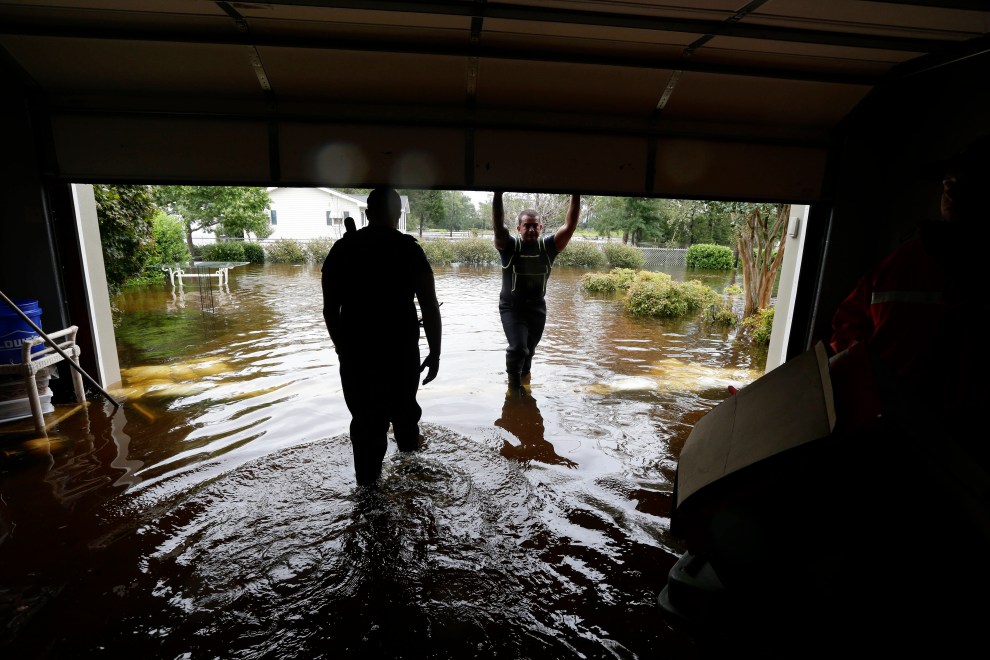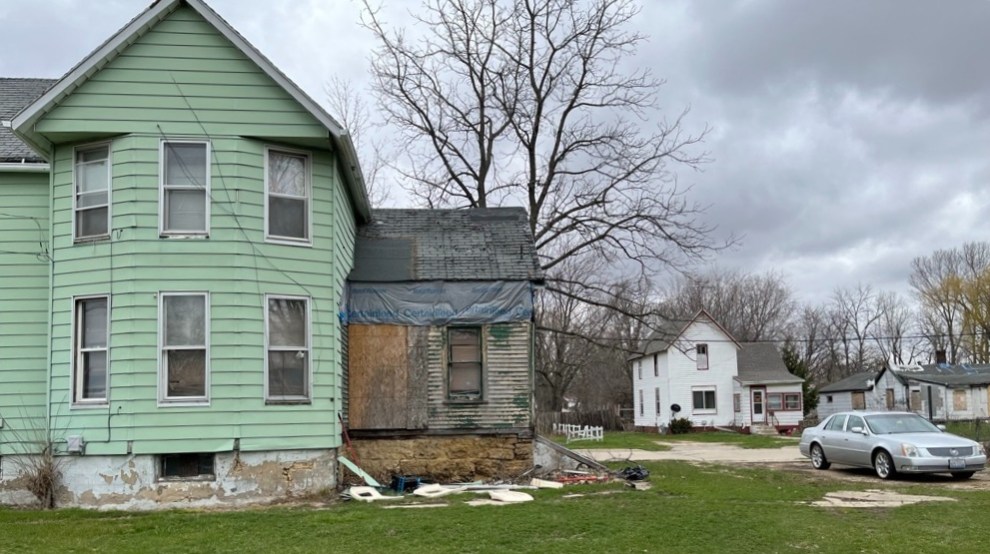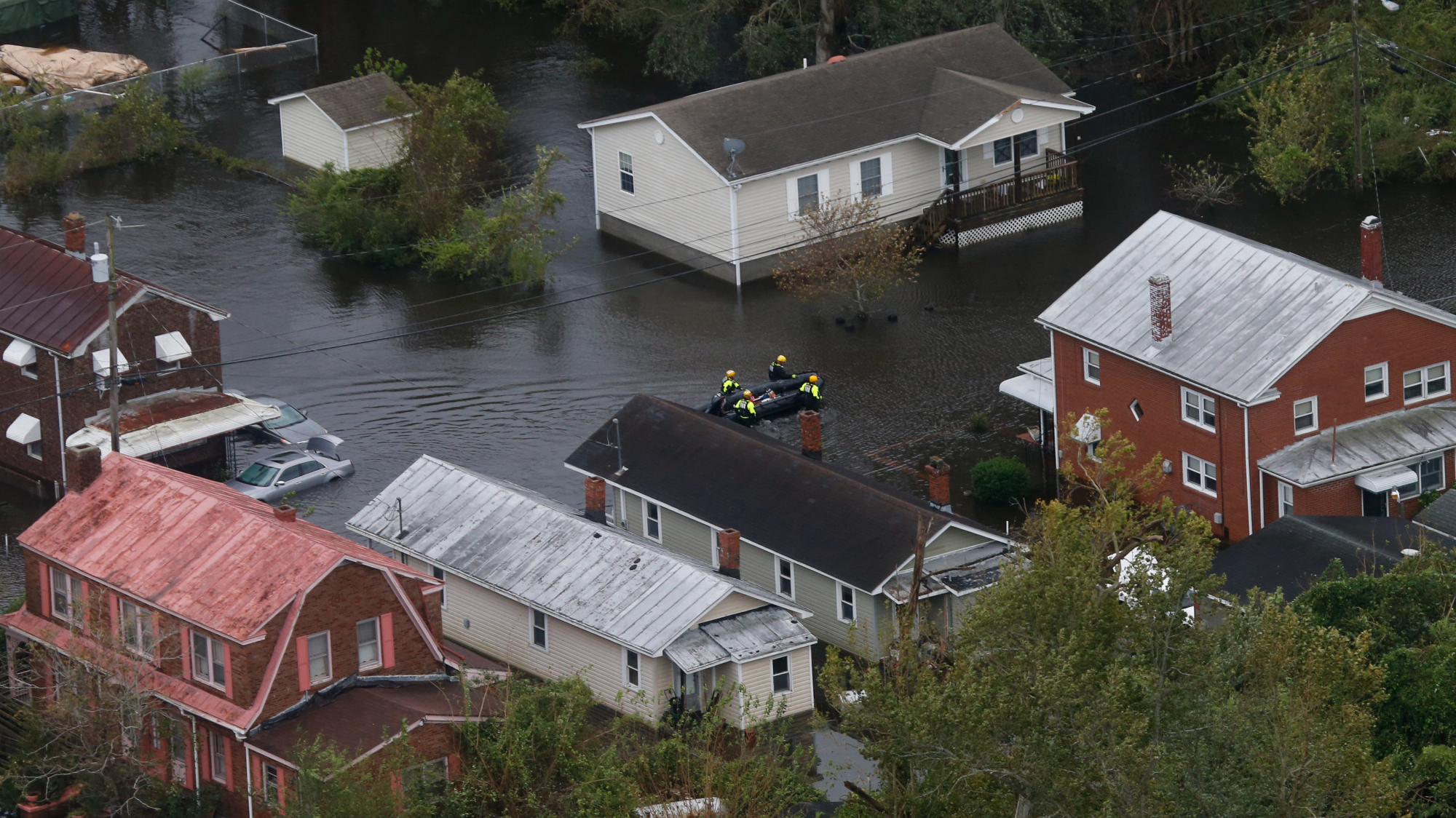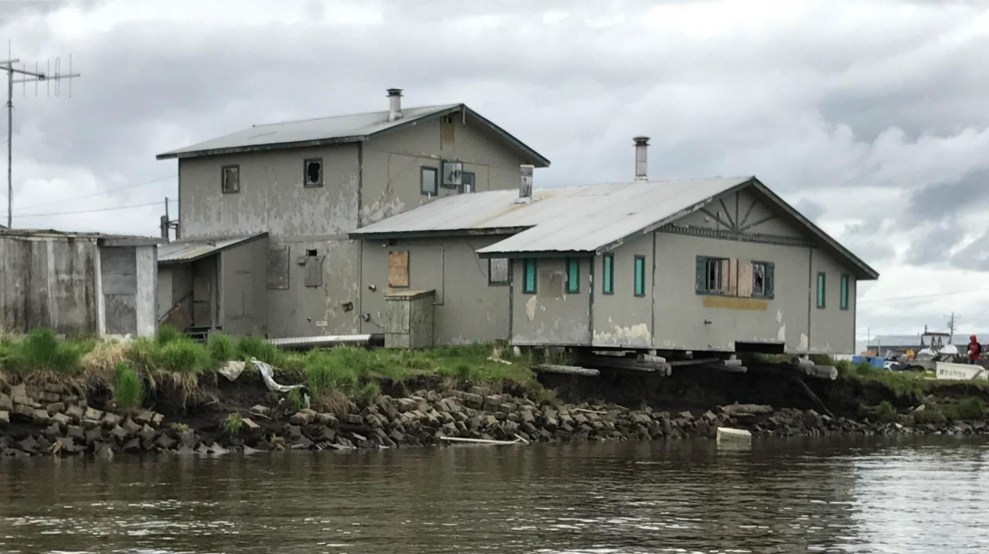This article was produced in partnership with Columbia Journalism Investigations, the Center for Public Integrity and Type Investigations.
NEW BERN, NC—Janice Crews knew time was not on her side after Hurricane Florence’s record-breaking storm devastated her flood-prone neighborhood on September 14, 2018.
The retired postal worker acted quickly. She recruited an activist friend, organized neighbors, met with city officials and signed a petition for the Federal Emergency Management Agency to buy out their homes in the North Hills Drive community. They wanted to move out of the floodplain to higher ground.
Weeks and then months passed. Crews became more and more anxious. FEMA and the local agencies it coordinated with did not seem to have the same sense of urgency she had: She was a widow in her mid-70s and the only caregiver of a disabled daughter.
“I was devastated. I had a nervous breakdown,” Crews said. “I couldn’t go through another flood.”
She considered her options, all bad, and decided she could no longer wait for the federal government. She sold her home of 18 years, ruined by water and mold, at a substantial loss.
FEMA eventually agreed that New Bern needed buyouts. But it took almost three years after Florence had flooded the city before the agency’s approval led to an actual purchase. By then, many homeowners who initially asked for help had either moved on their own or decided in frustration that some other anti-flooding measure would have to suffice.

Hurricane Florence pushed the Lumber River to an unprecedented 29 feet, damaging homes that still needed repair from damage done during Hurricane Matthew two years earlier.
Gerry Broome/AP
This is why the country’s largest effort to relocate people from flood zones isn’t working amid climate change. It’s not only denials that lock people out. Often, whatever assistance the government does offer comes too little, too late and doesn’t address the underlying problem: Entire neighborhoods and communities need help moving.
For decades, FEMA has funded voluntary buyouts under its “hazard mitigation” programs that support disaster preparedness initiatives. It’s moved people out of 50,000 properties, with states and municipalities doing key legwork and often sharing the cost. They then demolish the structures and return the land to open space in order to stop the cycle of damage and loss.
But the federal agency did not design its flood programs with mounting climate disasters in mind. FEMA buyout applications are complicated and the wait times are long—five years or more for the average homeowner, research shows. As millions of Americans discover in the coming decades that they must relocate because of rising sea levels, flooding rivers and intense storms, the mismatch between the buyout process and the need is going to get worse.
One potent example of that future: In Lumberton, North Carolina, residents eligible for a FEMA buyout after a 2016 hurricane found themselves slammed by another in 2018 before anyone could be moved out.
In a year of reporting on climate relocation, Columbia Journalism Investigations in partnership with the Center for Public Integrity and Type Investigations found that the government’s failure to meet the needs of communities facing climate challenges comes at a steep social and economic cost. It worsens inequities because those who can’t afford to wait for help, mostly low-income residents and people of color, are more likely to live in flood zones, research shows.
Columbia Journalism Investigations and its partners obtained data on FEMA-funded buyouts from 1989 through 2017. Nationwide, the vast majority of counties had fewer than 50 properties bought out over that time, and most had none.
But among counties hard hit by hurricanes or floods, places with a higher percentage of white residents than the national average received three times as many buyouts per capita.
“Buyouts for individual property owners have been demonstrated to exacerbate inequality, subsidize the wealthy and increase overall social vulnerability—even when they work as they are supposed to,” said Dan Abramson, a professor of urban planning at the University of Washington. “And they often do not.”
FEMA buyouts also were not intended to move entire communities, a type of assistance that climate change makes increasingly necessary. Instead, experts note, they were meant to remove risk to buildings on individual properties. As the federal government selectively acquires homes or residents leave on their own, both those who stay and those who go lose something. What remains are neighborhoods checkerboarded with empty lots.
For areas still suffering from once-legal discrimination in lending and housing, relocation brings even more challenges. In Freeport, Illinois, for instance, residents of a historically Black community feel stranded in the flood zone, doubting they will get enough money to afford to move—yet rules effectively bar them from making repairs to their flood-damaged homes.
“There’s a possibility for government-funded buyout programs” to address the need for climate relocation, said Anna Weber, a policy analyst at the Natural Resources Defense Council who has studied the FEMA programs. “Right now, they are not really up to the task.”
FEMA declined Columbia Journalism Investigations and its partners’ requests to interview senior officials who oversee these programs. In response to written questions, the agency described climate change as a “top priority” and noted the $5 billion in hazard-mitigation grants that it had funded in fiscal year 2021 to help cities and states address the growing need for adaptation and relocation.
“FEMA’s hazard mitigation assistance programs are evolving to better support our nation’s need to mitigate for climate change,” Jeremy Edwards, FEMA’s press secretary, wrote in an email.
He noted that the agency is launching a new effort, Swift Current, to “substantially speed up” funding to four states for certain homeowners hit by Hurricane Ida in 2021. But he also said that upping the number of buyouts around the country requires local and state agencies to prioritize the work and homeowners to opt in.
Two years after Crews bought her current home in New Bern and almost four years after Florence, she feels like a stranger in her own house. She misses her old neighborhood, the garden she tended for many years and the neighbors she called friends.
“I don’t like it here,” she said. “They don’t want anything to do with you.”
Crews’ new place is outside the floodplain. Even so, she doesn’t feel safe in the structure she calls a “piece of junk” because it’s not a brick home like the one she had on North Hills Drive.
The value of Crews’ former home dropped from $132,000 in 2010 to $97,000 in 2016, the year Hurricane Matthew dumped rain on the North Hills Drive neighborhood—flooding it but not as badly as Florence would two years later.
On April 18, 2019, she sold her home for just $39,500.
She’s frustrated about leaving a home she had already paid for and taking on a new mortgage—at 77—for a $136,000 home she hates. But after the two hurricanes and numerous other flooding events, she gave up.
“I feel that I did everything I could to get help,” Crews said. “The government wasn't going to do nothing.”
The river cutting through Lumberton, North Carolina, overflowed as Hurricane Matthew bore down on the city in October 2016, inundating homes on its south and west sides. The floodwaters soon overtook the impoverished city of about 20,000 near the South Carolina border. In some places, said Rob Armstrong, who directs the city’s public works department, they rose as high as eight feet.
The powerful storm devastated the west Lumberton home where Chris Howard and his wife, Gennifer, have lived since the early 1990s. Four feet of dirty water settled around their one-story bungalow, ruining everything low-lying, bleaching the plants in the yard and killing his peach trees. A city councilor who represents South Lumberton, Howard lost his most prized possessions, including the materials he used to teach Black history programs statewide.
“Everybody in this whole neighborhood...was flooded out,” he said. “Every individual was impacted.”
The Howards, like many of their neighbors, turned to the government seeking relief. City officials collected about 400 applications from Lumberton residents for FEMA buyouts, elevations and rebuilds and sent them to the official FEMA applicant, the state. State officials submitted just over 100 to FEMA for approval and deemed the remaining 300 ineligible for the federal agency’s aid.
FEMA eventually approved 47 homes for buyouts at just over $6 million after Matthew, agency records obtained by Columbia Journalism Investigations and its partners show. The agency also approved 20 elevations and 34 home repairs. The Howards were among those who got assistance to rebuild.
But in Lumberton, as in New Bern, the process dragged on. Officials did not finalize any of the aid until a year and a half later, in mid-July 2018.
Within two months, Hurricane Florence hit. The slow-moving storm hovered over the Lumber River long enough to overwhelm the temporary sandbagging the city had placed around it, pushing the river to an unprecedented 29 feet.
At the time, Howard had just bought flooring, wood trim and sheet rock. He was finally ready to fix up his house, he said, two years after the first hurricane. Florence wrecked the materials he’d bought for repairs. Again, his family lost everything.
“Your chairs, your furniture, gotta be removed—again,” he said. “Where does that leave you psychologically?”
He and his wife have since decided to switch from a reconstruction to a buyout because the process, he said, “took so long.” When the next storm hits—and Howard knows that it will—he can’t imagine having to wait years longer for FEMA aid to make the same repairs.
The Howards aren’t alone: 17 other homeowners opted to switch to FEMA buyouts after enduring a second storm rather than continue to elevate or rebuild their houses, city records show. The owners of another 10 homes withdrew from the program altogether. According to Brandon Love, Lumberton’s deputy city manager, some owners, including ones who sought a buyout, sold on the private market—putting new residents into flood-prone houses.
In a changing climate, back-to-back devastating storms will become more likely in Lumberton. Hurricanes are intensifying across the Carolinas. Said Kathie Dello, North Carolina’s state climatologist: “We’re just supercharging these storms.”
Meanwhile, FEMA’s buyouts can’t keep up.
The Lumberton buyout project approved after Matthew has yet to be completed—three purchases are still pending. The city has just started processing another 50 buyouts under Florence.
“We’ve had some people die before our program would get to them,” said Wayne Horne, Lumberton’s city manager.
Love put it simply: “It’s just a cumbersome program.”
It sprung from repeated failures to manage US flood risk.
Private insurance companies gave up insuring flood-prone properties over the first half of the 20th century, judging it an unprofitable business line. Congress intervened, creating the National Flood Insurance Program in 1968.
But instead of reducing flood risk, research showed, the flood-insurance program prompted more development in the floodplain.
And analyses by the Government Accountability Office, Congress’ investigative arm, showed that a small share of insured properties flooded over and over, repeatedly collecting these insurance payments.
That’s how FEMA buyout efforts came to be.
Congress authorized the agency in 1988 to reduce its insurance program’s liabilities and lessen the country’s flood risk by buying out flood-prone property. From 1989 to 2018, buyouts accounted for about 75 percent of FEMA’s $5.4 billion in flood mitigation spending, according to a 2020 GAO report.
But buyouts have proved difficult to carry out. And the flood-insurance program’s debt is ballooning as climate change worsens: nearly $1 billion in 1997, $17 billion in the aftermath of Hurricane Katrina in 2006 and over $20 billion at the end of 2021. That’s the trajectory even though Congress canceled billions of dollars in debt five years ago.
The same 2020 GAO report found that the number of repetitive-loss properties is increasing, and FEMA’s buyouts are not doing enough to prevent that.
“We reiterate our previous suggestion that Congress comprehensively reform the program to ensure its solvency and improve national flood resilience,” the GAO wrote.
It’s a mildly worded warning of an urgent need.
By 2100, the U.S. is projected to see up to twice as many intense rainfall days as it did in the latter part of the 20th century. Sea levels are on track to rise as much as seven feet over the same period. Hurricanes are getting wetter and lingering longer over land.
All of that means more flooding.
The Pecatonica River was overflowing its banks—again. Mounting rainfall and fast-melting snow fueled a one-two climate punch.
On that night in March 2019, Cheryl Erving had no choice but to evacuate her flooded neighborhood in Freeport, Illinois. A rescue boat, navigating the rising waters by flashlight, motored up to her home. There was only enough room for her to bring a single bag of possessions. The city warned residents this would be their last chance to get out.
Three years later, the first-grade teacher still hasn’t recovered. She has yet to replace her roof, marred by the hole the storm drilled through it. Every time it rains, water splashes onto her kitchen floor. Raccoons moved into her back porch. The floodwaters sat stagnant in her basement for nearly two weeks—long enough to crack her cement foundation.

Cheryl Erving's house was damaged by flooding in 2019.
Alex Lubben/Columbia Journalism Investigations
“I don’t know how long it will hold up,” she said of her still-damaged house. “It could collapse.”
Freeport, a city of about 24,000 people in northwest Illinois, has always flooded. But what happened that March night was historic. The Pecatonica River, which runs through the city, rose 17 feet—the highest recorded water level since 1933. In response, FEMA awarded the city a $3.4 million grant to buy out nearly 100 homes, all on the east side of town where Erving lives.
Erving wanted a buyout after that flood, she said. Her home was battered, and a fair offer would have given her a fresh start. But as time dragged on, she lost trust in the process. She no longer wants to take a buyout. “I don’t know anybody that’s going to,” she said.
Erving believes the city wants to raze her historically Black community to make way for a golf course.
A long legacy of racist housing practices here and across the country complicates relocation efforts. Communities still suffer the wealth-draining impacts of federal, state and city agencies forcing people of color into and out of neighborhoods. Buyouts strike many on Freeport’s east side as the 21st century version of that history.
Those same discriminatory practices put the area and many other communities of color at higher risk. The federal government’s 1930s-era redlining maps, which graded communities of color as “hazardous” for investment, bear a striking resemblance to current-day flood maps, according to an analysis from Redfin, a Seattle-based real-estate company.
On a hotter planet, the brunt of new flood risk will fall disproportionately on Black people, a recent study in Nature Climate Change found.
The federal government will have to reckon with present impacts of past discrimination to keep relocation from continuing that cycle. A 2020 study found that whiter communities are more likely to get buyout offers from FEMA while communities of color, with fewer alternatives, are more likely to accept—even as distrust keeps some residents locked in place.
For Erving, the problem runs deeper than doubts about officials’ intentions. If she takes a buyout at market rate, she likely couldn’t purchase a comparable home nearby. East side properties aren’t worth nearly as much as similar houses on the other side of town, part of a nationwide devaluing of Black homes.
Erving and several of her neighbors received assurances from city officials last year that the buyouts would make them whole. In order to compensate residents in segregated neighborhoods, FEMA can offer homeowners more than fair market value for their properties. Asked how often the agency has done this, FEMA said it did not keep track.
In February 2021, officials from FEMA’s regional office circulated a brochure saying that residents would be offered the market value of their home, plus a “supplemental payment of up to $31,000” so they could afford something comparable outside the floodway. The city said at the time that Erving and her neighbors would likely qualify for a payment close to the maximum allowed.
But after staff turnover at Freeport City Hall, that message changed. While residents may get a supplemental payment, Wayne Duckmann, who started his job in January as Freeport’s community and economic development director to oversee the buyout program, cautioned that he couldn’t promise them. FEMA noted that supplemental payments can be made at the city and state’s discretion.
“The city wants to provide that supplemental payment if it’s warranted,” Duckmann said. “It’s certainly not in our interest to withhold that payment.”
Erving said she would rather just repair her home, but she can’t do that, either. She doesn’t have the money to fix her busted foundation, and she wouldn’t be allowed to, anyway. Flood zone restrictions that apply only to the east side prohibit it.
Because the east side is in a federally designated floodway, it must be kept free of any new “encroachments” to allow room for floodwaters. That designation and an obscure FEMA regulation known as the “substantial improvement rule” effectively bar Erving and her neighbors from spending more than 50 percent of their home value on “improvements.”
Erving’s home, like many others on the east side, is valued at less than $7,000. To fix the foundation would likely cost more than the value of her home. Even replacing the damaged roof is a nonstarter. Erving estimates that to fully repair her house would cost $60,000.
The floodway regulation was meant to discourage new development in flood-prone places, but some living in Freeport see it differently.
“I believe they did this to keep people from doing what they needed to maintain their homes,” said Charles Hilton, a longtime resident. “That’s the way I always figured it.”
Much of what made the east side neighborhood feel like home is disappearing. The school that was a refuge for residents, around the corner from Erving’s house, has been shut down. Homes that have fallen into disrepair have been condemned. Black residents said it feels as though the city is waiting them out, eager to have them gone so Freeport’s white residents can relax and play sports there.
“If we wanted that, we would never have done the large, large, large amount of work to get help from FEMA,” Duckmann said when asked about residents’ concerns. “Turning your back on someone is not going through the hard work and years of public meetings.”
In May, property assessors began visiting homes on Freeport’s east side to determine how much the city would offer residents to purchase their properties. Erving remains conflicted about the prospect: If the offer were good enough, she said, she might reconsider a buyout.
“I feel like we’re up against a wall,” said Erving, who fears her house might be condemned if she allows assessors inside, leaving her with nowhere else to go. But she decided to do it anyway: “If I don’t let them in, we don’t get anything.”
Founded in 1710 by Swiss merchants, New Bern sits on the banks of the Neuse and Trent Rivers before they feed into the Pamlico Sound off the eastern coast of North Carolina. The location puts this city in the path of danger during the Atlantic hurricane season.
Despite earlier flooding, it wasn’t until 1996, when Hurricane Fran brought a 10-foot storm surge and eight inches of rain, that New Bern first applied for FEMA buyouts. The federal government approved the purchase of 19 properties two years later, as well as elevations for 64 homes, FEMA data shows.
Hurricane Florence was worse. The rivers crested to historic levels. Several hundred people had to be evacuated.
As floodwaters receded, property owners documented $100 million in residential and commercial damages—4,325 homes and 300 businesses in and around the city. Most of those affected lived in New Bern’s most vulnerable neighborhoods, where 36 percent of the population lives at or below poverty level.
After recovery efforts began, the city circulated a form asking homeowners whether they might want to apply for FEMA buyouts or elevation grants. By the December 2018 deadline, the owners of at least 50 homes checked the box expressing interest in buyouts, documents show.
Months passed. City staff completed an application asking for “expedited” processing for just five homes, three of which the state ultimately submitted to FEMA in May 2019. A year later, FEMA gave New Bern the green light to make the purchases. None of the 29 homeowners on North Hills Drive who signed the petition immediately after the storm—including Crews—received a buyout in this first phase.
A few more buyouts are coming: The city got approval from FEMA for 13 more properties in September 2021. But some owners sold to private buyers while another decided to elevate a home instead, according to Keith Acree, a spokesperson for North Carolina Emergency Management.
None of those remaining buyouts have been finished yet, nearly four years after the hurricane swept through. Seven of those eight pending purchases are in the North Hills Drive area, city officials say.
One of the completed buyouts was Annette Canady’s childhood home, on Beech Street near a river and creek. Canady waited eight months after she had signed the initial May 2020 sales agreement before finding out what her purchase price would be. This buyout, like the other two, was mostly funded by FEMA, while the city managed the transaction.
The lack of information from the city added more stress, Canady said. She would have been homeless during that time, she said, had it not been for a friend who let her stay in his house for 2 ½ years until the $65,221 deal finally closed in February 2021.
“I don’t think they handled it right,” she said of the city’s role in the buyout process.
This was not just any house to Canady, 66, who has two children, three grandchildren and a great-grandchild. She grew up there with her siblings after her parents bought the property in 1963. It was waiting for her after divorce. It was where she played with her kids and grandkids. All that is left is the memories.
Now she rents, making ends meet on a fixed income.
“People say, ‘Well, go here or go there,’” Canady said, recounting advice she gets to buy a place. “And I said, ‘You don’t understand. There is nowhere to go.’ There are no houses that you can afford.”
New Bern Mayor Dana Outlaw said he’s disappointed by the small number of buyouts and elevations FEMA approved. Still, records show the federal agency approved the lion’s share of the properties the city asked to purchase.
“I don’t know if some communities have more political clout, or if they are filling out the applications better than we are,” said Outlaw, who did not respond to questions about why the city didn't ask for more buyouts.
Experts note that a lack of resources and expertise at the local level remains one of the biggest obstacles preventing municipalities from participating in FEMA programs.
NRDC’s Weber said that a few cities and states are thinking about “how to do buyouts in a faster and more equitable way,” but what they need is a streamlined way to access resources. “That is something that most places just don’t have.”
Weber and other experts emphasize one major problem is that these programs are competitive. Communities with more resources will always be better equipped to go after funding than their poorer counterparts.
Mathew Sanders, senior manager at the nonprofit Pew Charitable Trusts, argues that the federal government should offer funding and other resources directly to flood-prone communities to help them adapt and relocate rather than make them apply for aid.
“If we think about it more as service delivery, as opposed to say funding availability, then I think we could start moving toward better outcomes,” he said.
Abramson, of the University of Washington, suggests a fundamental reform: Buyout programs must focus not on individual property purchases but on what he calls “collective aid.” Helping communities move together is more equitable than helping homeowners move alone, he said.
In the North Hills Drive neighborhood, which sits in a dip, surrounded by a canal and near a creek, the risk for future flooding looms large. After Florence, four residents elevated their homes on their own and with the help of charity organizations. Others, including Crews, gave up and sold.
Neighbor Verleria Bryant and her husband, Charles, raised three sons in the three-bedroom house they’ve owned for three decades.
Water from Florence, which reached as high as three feet inside the house, destroyed everything. Interior walls needed replacing. Flood insurance didn’t cover the ruined furniture and appliances.
In the midst of all this, the Bryants felt pressured to quickly decide on something the city and FEMA would process far more slowly: buyout or elevation?
“We were so emotionally drained that you can’t make that decision in that short period of time,” she said as she sat in her backyard.
The Bryants didn’t know where they could go if they did move. The couple had initially signed the petition asking for a buyout but said they changed their minds and opted for an elevation.
They didn’t get it. The city told Public Integrity it has no record of that request.
Now, still living on North Hills Drive, the couple hopes against hope that the area won’t flood again. Bryant doesn’t understand why no assistance ever reached them.
“That’s why we got the government,” she said, “to help us when we need them.”
Columbia Journalism Investigations research assistants Gabriela Alcalde and Samantha McCabe contributed to this story.
Mc Nelly Torres is an editor for the Center for Public Integrity. Alex Lubben and Zak Cassel are reporting fellows for Columbia Journalism Investigations, an investigative reporting unit at the Columbia Journalism School. Public Integrity and Type Investigations, two nonprofit investigative newsrooms, provided reporting, editing, fact checking and other support. Additional funding for this story was provided by the Fund for Investigative Journalism.
















